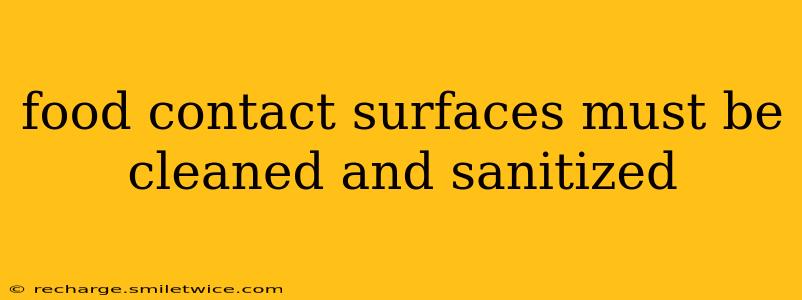Maintaining the cleanliness and sanitation of food contact surfaces is paramount in preventing foodborne illnesses. This isn't just a recommendation; it's a crucial step in ensuring food safety and protecting public health. This guide delves into the critical aspects of cleaning and sanitizing food contact surfaces, addressing common questions and providing best practices for various settings, from restaurants to home kitchens.
What are Food Contact Surfaces?
Before we dive into cleaning and sanitizing, let's clarify what constitutes a food contact surface. These are any surfaces that come into direct contact with food during preparation, processing, storage, or serving. This includes:
- Equipment: Cutting boards, knives, utensils, mixing bowls, food processors, slicers, grinders, ovens, and refrigerators.
- Containers: Plates, cups, glasses, serving dishes, storage containers, and packaging materials.
- Work surfaces: Countertops, tables, sinks, and drains.
Why Clean and Sanitize Food Contact Surfaces?
Regular cleaning and sanitizing are essential for several reasons:
- Preventing Cross-Contamination: Harmful bacteria, viruses, and parasites can easily transfer from contaminated surfaces to food, causing illness. Cleaning removes visible soil and food particles, while sanitizing eliminates microorganisms.
- Meeting Regulatory Requirements: Food safety regulations mandate the regular cleaning and sanitizing of food contact surfaces in food service establishments. Failure to comply can result in penalties and legal action.
- Maintaining Food Quality: Cleanliness extends the shelf life of food and prevents spoilage by removing microorganisms that can cause decomposition.
- Protecting Public Health: Proper sanitation minimizes the risk of foodborne illnesses, safeguarding the health of consumers.
What's the Difference Between Cleaning and Sanitizing?
Many people confuse cleaning and sanitizing. They are distinct processes:
- Cleaning: The process of removing visible soil, food residue, and other debris from a surface. This usually involves washing with soap and water.
- Sanitizing: The process of reducing the number of microorganisms on a surface to a safe level. This often involves using a chemical sanitizer or heat.
How Often Should Food Contact Surfaces Be Cleaned and Sanitized?
The frequency of cleaning and sanitizing depends on several factors, including the type of food being handled, the level of contamination, and the type of surface. However, as a general rule:
- Regular Cleaning: Food contact surfaces should be cleaned frequently throughout the day, especially after each use.
- Sanitizing: Sanitizing should follow cleaning and typically occurs after each task or at the end of the day. High-risk areas may require more frequent sanitizing.
What are the Best Cleaning and Sanitizing Methods?
Effective cleaning and sanitizing involves a systematic approach:
- Pre-cleaning: Remove visible debris and food particles from the surface using a scraper, brush, or cloth.
- Washing: Wash the surface thoroughly with hot, soapy water. Use a detergent specifically designed for food service use.
- Rinsing: Rinse the surface with clean water to remove all traces of soap.
- Sanitizing: Apply a food-grade sanitizer according to the manufacturer's instructions. Allow the surface to air dry. Alternatively, you can use hot water sanitizing (at least 171°F (77°C) for at least 30 seconds).
Common Sanitizers: Chlorine bleach solutions, iodine solutions, quaternary ammonium compounds. Always follow the manufacturer’s instructions carefully and ensure the sanitizer is appropriate for food contact surfaces.
What are Some Common Mistakes to Avoid?
- Not Cleaning Thoroughly: Failing to remove all visible soil before sanitizing reduces the effectiveness of the sanitizing process.
- Using Incorrect Sanitizer Concentration: Using too little or too much sanitizer can render it ineffective.
- Not Allowing Sufficient Contact Time: Sanitizers require a specific contact time to work effectively.
- Improper Drying: Allowing surfaces to air dry is essential; using contaminated cloths for drying can recontaminate surfaces.
How to Clean and Sanitize Different Types of Food Contact Surfaces?
Specific cleaning and sanitizing methods may vary depending on the material of the food contact surface. Refer to manufacturer instructions for detailed guidance on cleaning various materials, including plastics, wood, and stainless steel.
What are the Legal Requirements for Cleaning and Sanitizing Food Contact Surfaces?
Local health codes and food safety regulations mandate specific cleaning and sanitizing protocols. It's crucial to consult with your local health department or regulatory agency for detailed information on compliance requirements. Failure to adhere to these regulations can result in fines or even closure of the establishment.
This guide provides a general overview of cleaning and sanitizing food contact surfaces. Always prioritize food safety and consult relevant regulations and resources for specific instructions and best practices. Remember, safe food handling starts with clean and sanitized surfaces.
